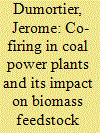| Srl | Item |
| 1 |
ID:
124333


|
|
|
|
|
| Summary/Abstract |
Several states have a renewable portfolio standard (RPS) and allow for biomass co-firing to meet the RPS requirements. In addition, a federal renewable fuel standard (RFS) mandates an increase in cellulosic ethanol production over the next decade. This paper quantifies the effects on local biomass supply and demand of different co-firing policies imposed on 398 existing coal-fired power plants. Our model indicates which counties are most likely to be able to sustain cellulosic ethanol plants in addition to co-firing electric utilities. The simulation incorporates the county-level biomass market of corn stover, wheat straw, switchgrass, and forest residues as well as endogenous crop prices. Our scenarios indicate that there is sufficient feedstock availability in Southern Minnesota, Iowa, and Central Illinois. Significant supply shortages are observed in Eastern Ohio, Western Pennsylvania, and the tri-state area of Illinois, Indiana, and Kentucky which are characterized by a high density of coal-fired power plants with high energy output.
|
|
|
|
|
|
|
|
|
|
|
|
|
|
|
|
| 2 |
ID:
115151


|
|
|
|
|
| Publication |
2012.
|
| Summary/Abstract |
This study presents a linear profit model with combined economic and environmental factors for a switchgrass-for-biofuels agricultural system in the southeastern U.S. The objectives are to establish conversion-to-switchgrass thresholds for various market prices and identify policy incentives that would ensure economic profit while also maximizing environmental benefits (carbon sequestration, displacement of fossil fuels) and minimizing negative impacts (global warming potential, nitrate loss). Weighting factors are chosen to represent incentives and penalties by assigning value to the impacts. With no other incentives, switchgrass market prices of at least $51 and $58/dton would be needed in order to make a profitable switch from corn/Conservation Reserve Program (CRP) lands and cotton, respectively. At a mid-range offering of $50/dton, feasible carbon credit prices of $3/ $8/ $23 per metric tonne CO2e would incentivize conversion from corn, CRP, or cotton, respectively. Similarly, a water quality penalty of $0.20/ $3/ $2 per kilogram NO3-N leached would incentivize the same conversions with resultant watershed improvement. At a lower price of $30/dton switchgrass, incentives based on valuation of ecosystem services begin to exceed feasible ranges of these valuations.
|
|
|
|
|
|
|
|
|
|
|
|
|
|
|
|